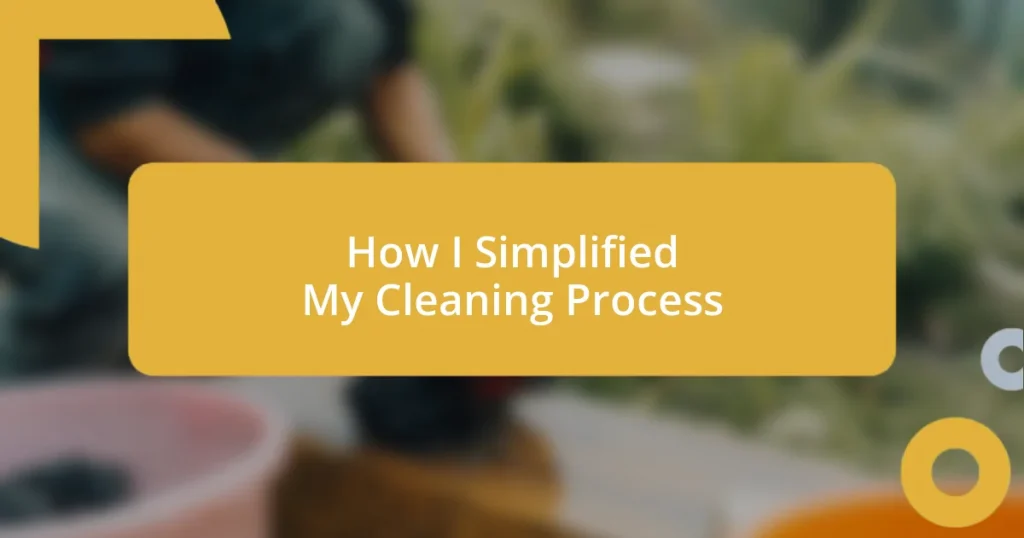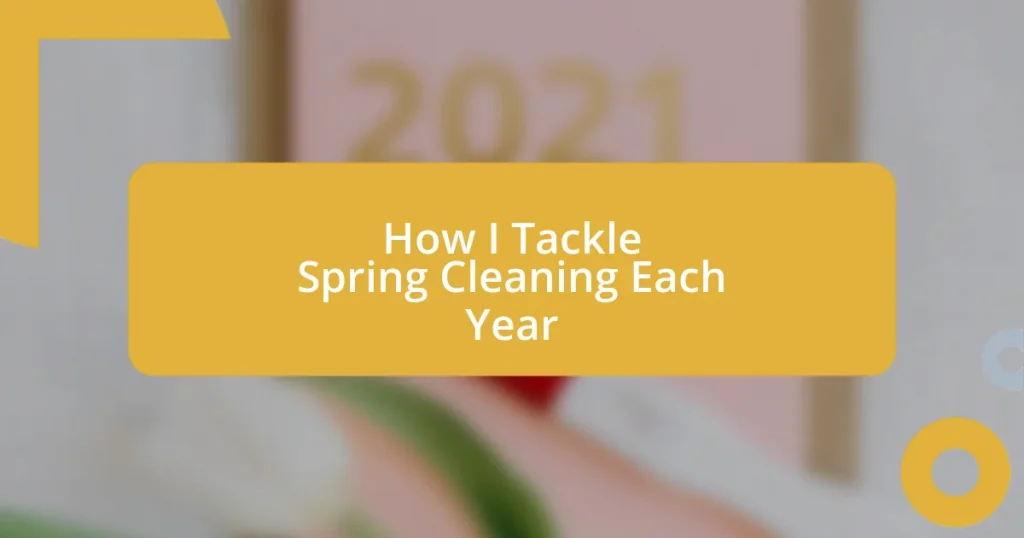Key takeaways:
- Identifying specific cleaning challenges and emotional attachments helps streamline the cleaning process and prioritize tasks effectively.
- Establishing a structured cleaning schedule by dividing tasks throughout the week reduces overwhelm and creates a more organized living space.
- Regularly reviewing and adjusting cleaning methods, along with a flexible approach, enhances efficiency and keeps the cleaning routine enjoyable and manageable.
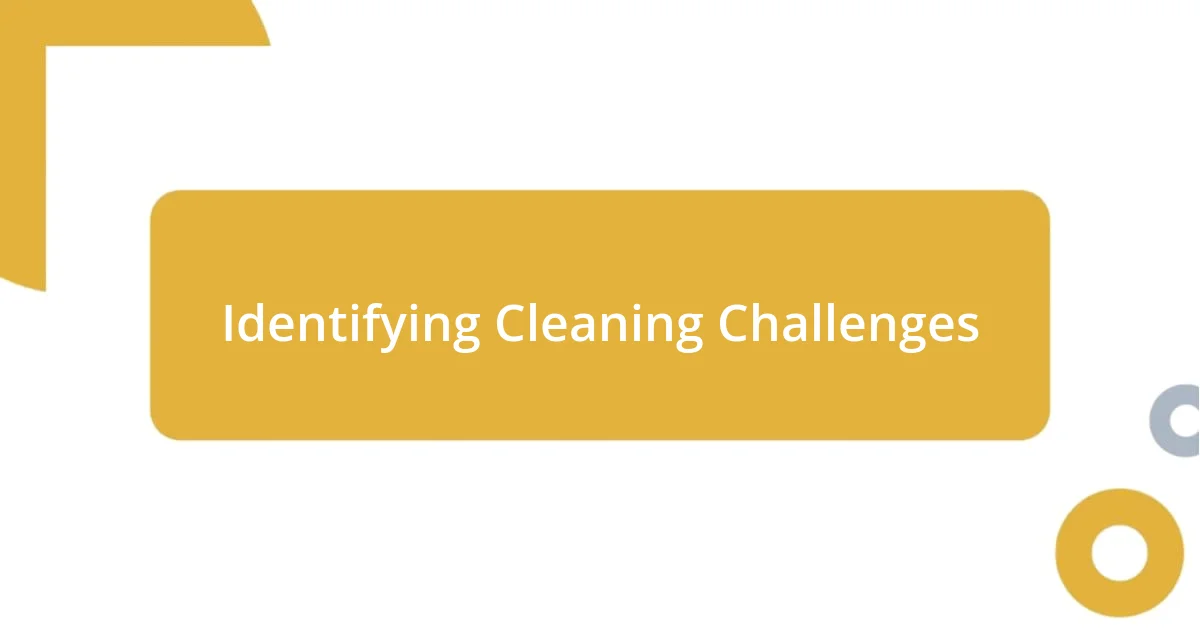
Identifying Cleaning Challenges
When I first started cleaning my home, I noticed certain areas always seemed to be neglected. The corners behind furniture, like the ones behind my dining table, collected dust bunnies as if they were trying to hide from me. This made me realize that identifying cleaning challenges requires a keen observation of where dirt tends to accumulate most.
I remember feeling overwhelmed by the sheer variety of surfaces and materials in my home. Honestly, it was a bit daunting to consider how to tackle everything at once. Have you ever felt that way? Instead of trying to clean everything in one go, I learned to pinpoint specific problem areas, like the kitchen counters after a big meal or the bathroom sink that seemed to attract soap scum.
Emotional attachment to certain belongings can also complicate our cleaning process. I found it hard to let go of items – like that old chair with sentimental value – even though it was a magnet for clutter. That’s when I realized that addressing our emotional relationship with our spaces is just as important as the physical act of cleaning. What challenges have you faced in this regard?
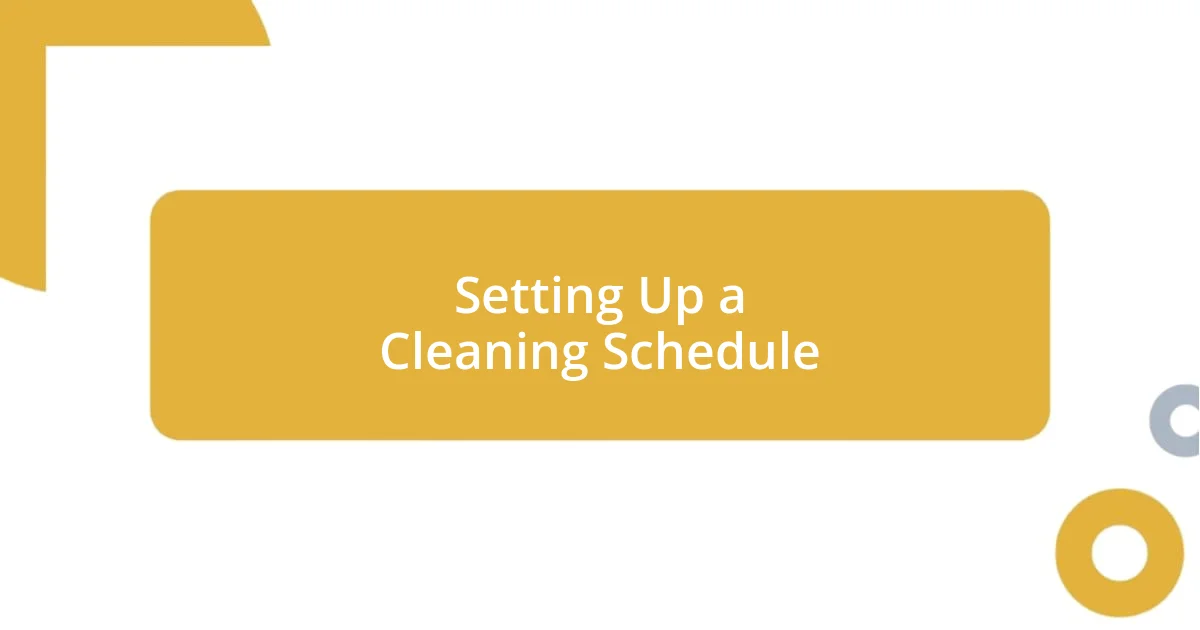
Setting Up a Cleaning Schedule
Establishing a solid cleaning schedule transformed my home maintenance routine. I discovered that breaking down tasks into manageable chunks made cleaning feel less overwhelming. By dedicating specific days to certain areas, I could tackle my home systematically instead of floundering through my to-do list.
Here’s how I structured my cleaning schedule:
- Monday: Dust surfaces in common areas.
- Tuesday: Clean the kitchen, focusing on countertops and appliances.
- Wednesday: Tackle the bathrooms, ensuring sinks and toilets shine.
- Thursday: Vacuum or mop all floors throughout the house.
- Friday: Declutter and organize any out-of-place items, especially in living spaces.
- Saturday: Focus on a deep clean of one room or area, like the bedrooms or garage.
- Sunday: A relaxed day to catch up on any missed tasks or simply enjoy a clean space.
I remember when I first started this schedule; I felt like I was just marking time. But slowly, I noticed the difference. Each week, my home felt more organized, and I began to appreciate the time I spent on upkeep. It’s surprising how a little structure can lead to a much more peaceful living environment.
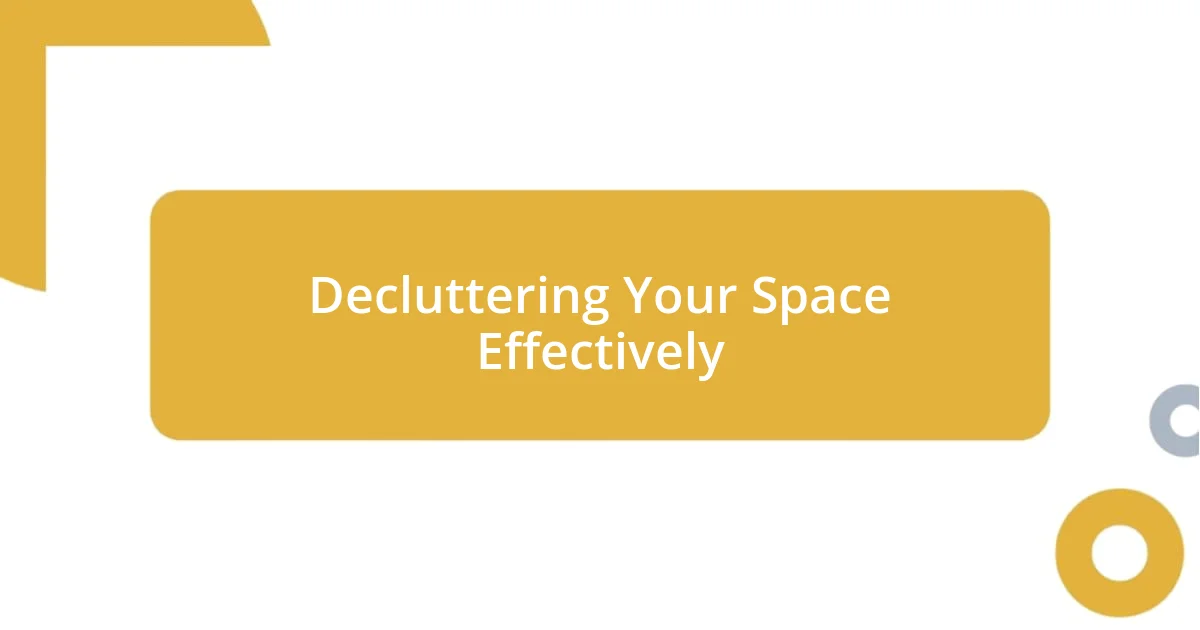
Decluttering Your Space Effectively
When it comes to decluttering your space effectively, I’ve discovered that the first step is truly letting go. I recall standing in my living room, filled with knick-knacks and memorabilia that once held special memories. It was tough, but clearing out those items I didn’t use anymore fostered a sense of liberation. Have you ever felt that rush when creating empty space? It’s invigorating!
I’ve often applied the “one in, one out” rule – for every new item that comes into my home, an old one has to leave. This transformed how I viewed purchases. Rather than impulsively buying new decor, I now consider how it adds to my space. You wouldn’t believe how this simple mindset shift changed my shopping habits. My space feels lighter and more open, and I genuinely enjoy being in it more.
I also learned to categorize the decluttering process. For example, I would assign boxes for “keep,” “donate,” and “trash” in each room. This made decision-making easier. Instead of feeling overwhelmed by what to do with everything, I could focus on each item and its purpose in my life. That clarity brought me immense satisfaction. How do you decide what to keep? This approach makes it easier to assess the value of my belongings.
| Decluttering Strategies | Description |
|---|---|
| One in, One Out | This rule encourages you to maintain a balance in belongings by letting go of an item for each new one acquired. |
| Box Method | Using labeled boxes (“keep,” “donate,” “trash”) simplifies decisions and helps organize decluttering sessions. |
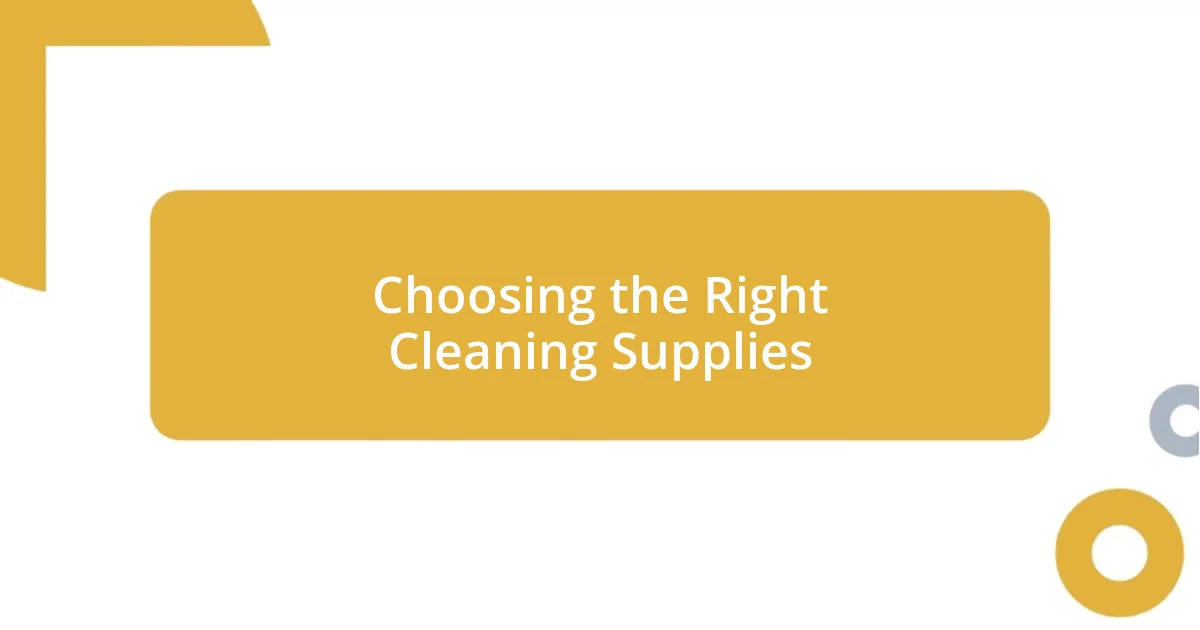
Choosing the Right Cleaning Supplies
When it comes to choosing the right cleaning supplies, I’ve found that simplicity is key. For years, I over-complicated things, stocking up on various products for every conceivable surface. Now, I stick to a few multi-purpose items that tackle several tasks. It’s incredible how just a reliable all-purpose cleaner and microfiber cloths can work wonders in my home. Have you ever thought about how much money and space you could save with this approach?
I recall feeling overwhelmed trying to decipher endless labels on cleaning solutions. One day, I decided to take a closer look at the ingredients instead of just the marketing claims. To my surprise, opting for natural alternatives not only eased my cleaning routine but also eased my mind about chemical exposure. Now, I usually reach for vinegar and baking soda—they’re non-toxic and surprisingly effective. Isn’t it refreshing to know that you can clean your home without harsh chemicals?
Another lesson I learned was to consider my environment when selecting supplies. Living in a cluttered space, it felt unmanageable; however, investing in efficient storage for those cleaning supplies made a huge difference. I once stashed everything in a single drawer, leading to frantic searches mid-cleaning. Organizing my supplies into a caddy, which I can easily transport from room to room, has streamlined my process significantly. How does your cleaning supply organization affect your motivation to clean? Trust me, when everything is easy to find, the task feels less daunting.
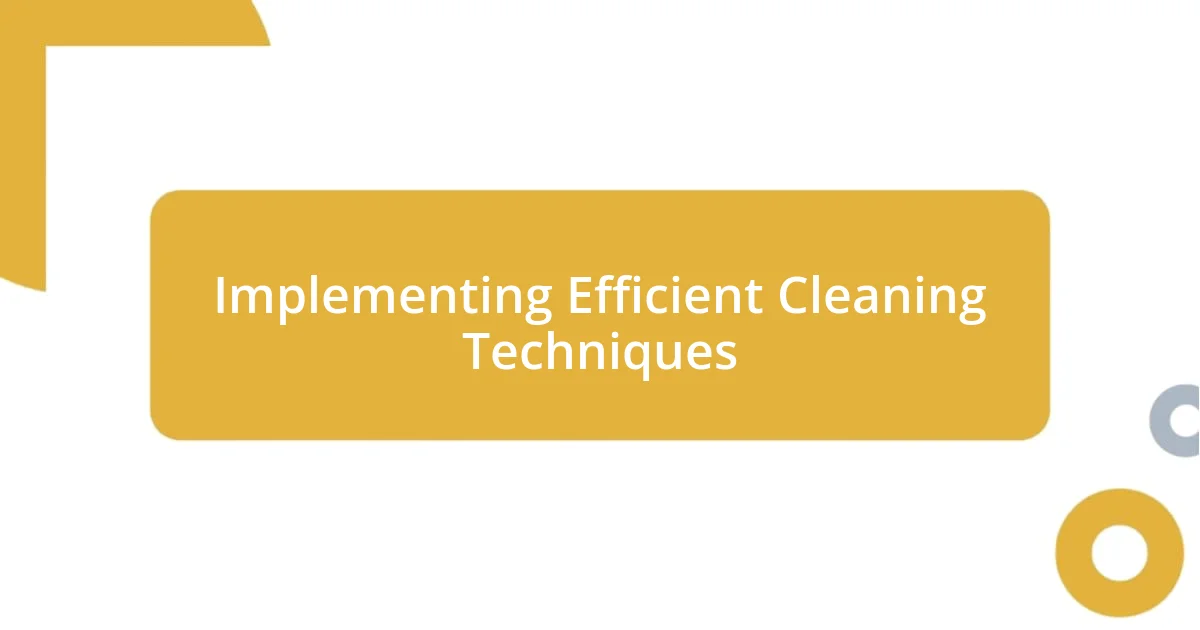
Implementing Efficient Cleaning Techniques
Implementing efficient cleaning techniques transformed my cleaning routine in ways I never expected. For example, I started using the “top-to-bottom” approach, which meant dusting and cleaning higher surfaces first before moving to lower areas. This mindset shift not only maximized my efforts but also meant that I avoided having to re-clean surfaces later on. Have you ever felt frustrated when you end up cleaning the same spot more than once? I sure have!
I discovered that creating a cleaning schedule tailored to my lifestyle was a game-changer. By designating specific days for particular tasks—like vacuuming on Wednesdays and bathrooms on Saturdays—I relieved myself of that nagging sense of chaos. This simple strategy allowed me to break down larger chores into manageable bites. How often do you find yourself cramming all your cleaning into one exhausting session? Trust me, spreading tasks out makes the whole process feel lighter.
In addition, I began incorporating a timer during cleaning sessions, which might sound a bit quirky but truly worked wonders for me. Setting a timer for 15 minutes turned cleaning into a fun little challenge. I’d race against the clock, focusing completely on one room or task. The urgency helped me stay motivated and ultimately made cleaning feel less like a chore and more like a satisfying game. Have you considered giving this technique a try? It’s amazing how a small change in mindset can redefine the cleaning experience!
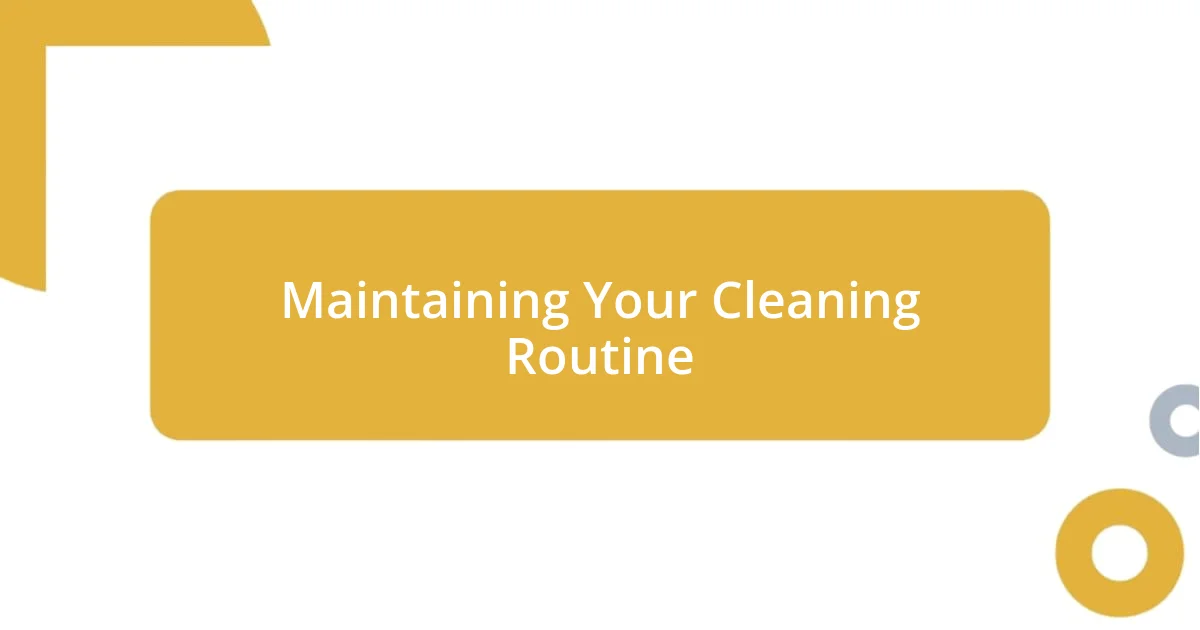
Maintaining Your Cleaning Routine
Maintaining a cleaning routine can feel daunting, but it’s all about finding your rhythm. I’ve discovered that setting aside just five minutes at the end of each day for quick tidying can lead to a surprisingly tidy home. It might sound trivial, but after a long day, I often felt overwhelmed by the clutter. Now, those few minutes make a significant difference in how I feel when I wake up to a clean space.
One tip I swear by is the power of a checklist. I created a simple, visual checklist that hangs near my cleaning supplies. Every time I complete a task, like vacuuming or dusting, I get to check it off—talk about instant gratification! Have you ever noticed how satisfying it can be to see progress in real-time? Each tick not only motivates me to keep going but also reassures me that I’m making consistent efforts.
Lastly, I’ve learned that consistency is key. I often remind myself that skipping a day doesn’t mean I’ve failed; it simply means I’ll pick up where I left off. Life happens, and things get busy. By allowing myself the grace to adjust my routine without guilt, I’ve found the process much more enjoyable. Have you ever felt pressured to maintain a perfect routine? Trust me, embracing imperfections makes sticking to your cleaning routine sustainable and far less stressful.

Reviewing and Adjusting Your Process
Reviewing your cleaning process is essential for making it effective and enjoyable. I often take a moment every month to look back at what worked and what didn’t. Recently, I realized that my bathroom routine was taking too long; it drained my energy. By tweaking my method, focusing on one area at a time instead of the entire space, I noticed not only did it save me time, but it also made the task feel less daunting. Have you ever found yourself dreading a particular chore? Reflecting on what slows you down can lead to surprisingly effective changes.
Adjusting your cleaning approach isn’t just about efficiency; it’s also about embracing change. I’ve come to understand that when my life shifts—like seasons or new family schedules—my cleaning routine needs to adapt too. For instance, during the summer, I found that I didn’t need as strict a schedule because spontaneous activities pulled me outdoors. I adjusted my plan to focus more on outdoor cleaning tasks when it was too hot to stay inside. Have you considered how your routine might change with the seasons? Flexibility in your cleaning process can turn chores into a manageable part of your life.
Sometimes, I conduct informal “cleaning reviews,” asking myself what I enjoy most about my process. Recently, I found that I loved the scent of a specific cleaner I was using; it became a little reward. It’s moments like these that keep me motivated. Each month, I reassess my cleaning supplies to see if there’s anything that excites me or sparks joy. By prioritizing what feels good rather than sticking rigidly to old habits, I keep the routine fresh and enjoyable. What about you—when was the last time you looked closely at the tools you use? Adjusting your process based on what feels right can transform cleaning into something uplifting.










